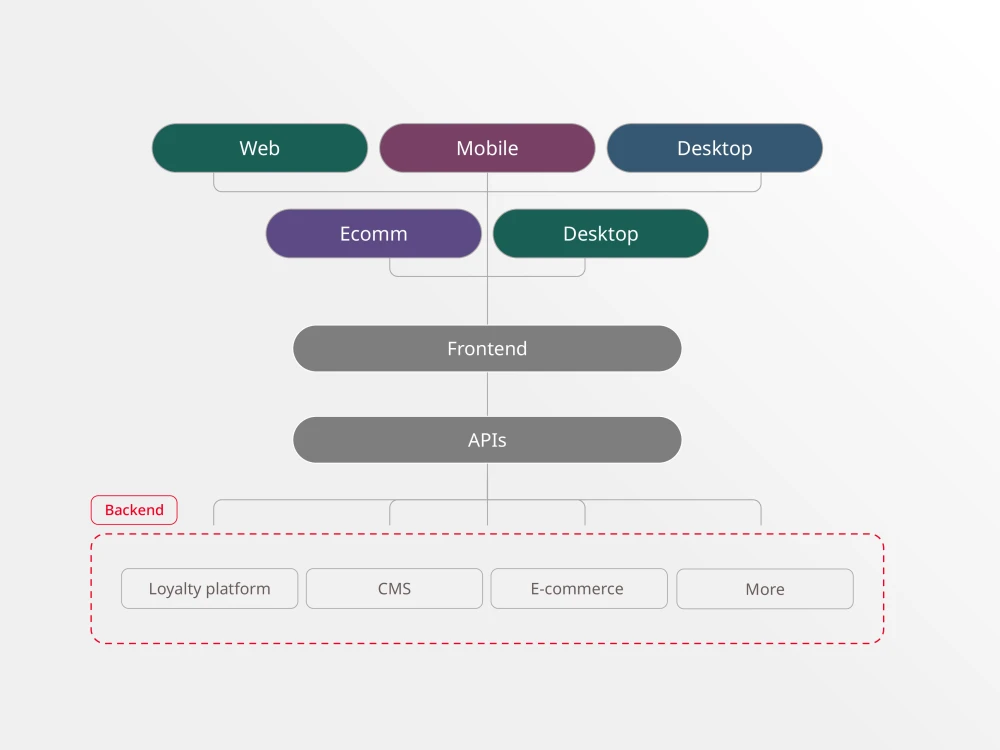Any business using a traditional CMS should at least consider how a headless CMS could simplify and accelerate the way they share consistent content with audiences across multiple platforms. Organizations today have found that traditional content management systems often create bottlenecks in their content delivery process, especially when trying to reach audiences across websites, mobile apps, IoT devices and emerging digital channels.
This is the simple message from Omavi Walker, Senior Software Engineer at Brightspot, who explained the benefits of hybrid and headless CMSs in our October 2021 webinar, “Why Content Teams Should Consider a Headless CMS.” With over a decade of experience in content management systems, Walker emphasizes how headless content management is transforming the way organizations approach content creation and distribution, enabling content teams to focus on storytelling and audience engagement rather than technical implementation across different platforms.
Complete control over your content means that your published data can be used on any device, leaving the team focused on storytelling and engagement rather than content delivery.
What is headless CMS?
Before getting into the pros and cons of a headless approach, Walker took time to explain the difference between a traditional and headless CMS architecture, highlighting how each system fundamentally manages and delivers content.
“A traditional CMS manages your entire web application end-to-end and usually dictates the technologies used throughout from the creation and storage of content to the presentation of that content on a website,” he said. “This monolithic architecture means that both content management and content presentation are handled within the same system.”
“There is very little flexibility in a traditional CMS as the data and presentation layers are tightly coupled with very little technical freedom, as you are required to use the technologies of the CMS,” Walker continued. “The rigid architecture often constrains organizations to specific frameworks and tools, and moving off such a system usually requires rebuilding your entire web application from scratch.”
Explaining how this differs from a headless approach, Walker added during the webinar: “Headless CMS removes the presentation system altogether and instead just delivers data, usually via JSON. In this model you have complete front-end freedom. You can use whatever front-end technology you would like and if you decide to migrate to a different headless CMS later on, you do not have to rewrite your entire front end.”
This architectural separation between content creation and content presentation is what makes headless content management particularly powerful. “The decoupled nature of headless CMS means your content becomes a reusable resource that can be delivered through APIs to any platform or device,” Walker explained. “This flexibility is essential in today’s digital landscape where organizations need to reach audiences across multiple channels while maintaining content consistency.”
Headless can help by keeping developers in a constant position to iterate so they can focus on adding new experiences rather than focusing time on implementing the same solutions on different platforms. Your editors can focus on their content rather than repetitive publishing of it.
Benefits of a headless CMS for content teams
Splitting the content creation and presentation processes gives organizations complete control over their content and lets them be more flexible in its use. This separation is fundamental to modern content management strategies, enabling teams to adapt quickly to changing digital demands.
For example, once a news story has been written, media organizations using a headless CMS can then publish that single piece of content on a website, a smartphone, a social media platform or broadcast it via a smart speaker. They do not need to reconfigure the content for these different channels and/or devices. This omnichannel approach ensures content consistency while significantly reducing the time and resources needed for content distribution.
“Your published data can be used on any device, leaving the team focused on storytelling and engagement rather than content delivery,” Walker shared during the webinar. “This streamlined approach allows content creators to maintain their creative momentum without getting bogged down in technical implementations.”
Headless can help by keeping developers in a constant position to iterate so they can focus on adding new experiences rather than focusing time on implementing the same solutions on different platforms. Your editors can focus on their content rather than repetitive publishing of it.
And this flexibility leads into another major benefit of a headless CMS approach as Walker explained. The ability to rapidly adapt to new channels and technologies gives organizations a competitive edge in the fast-evolving digital landscape.
Complete control over your content means that your published data can be used on any device, leaving the team focused on storytelling and engagement rather than content delivery.
He said: “Your content also becomes inherently more future-proof, since any new platform using different technologies can be immediately taken advantage of using your existing infrastructure. This adaptability ensures your content investment maintains its value over time, regardless of how technology evolves.”
“Developers appreciate this flexibility as it allows them to utilize their favorite frameworks and technologies and to provide their best work as efficiently as possible. This freedom of choice in development tools leads to more innovative solutions and faster implementation times.”
A headless CMS also lets teams focus on what they do best. For example, developers can spend more time on adding new experiences to the front end and coming up with more ways to publish the content. They do not have to spend time working out the best way to publish the same piece of content across existing platforms. This specialization of roles leads to higher quality outputs and more efficient workflows.
Similarly, editors can focus on creating the content instead of tweaking and repurposing it for different channels, platforms and devices. This streamlined content creation process allows for better quality control and more consistent messaging across all channels.
“A headless CMS empowers your business to future-proof itself and remain relevant in the changing digital landscape,” Walker advised. “The platform’s flexibility ensures your organization can quickly adapt to emerging technologies and changing consumer preferences.”
The content you have created is always available and can be migrated to a new CMS or published by new technologies as they are developed and brought to market. In a traditional CMS the content stays within the confines of the system and so becomes siloed and most likely obsolete as time advances. With a headless approach, your content repository becomes a valuable asset that grows in value as you expand your digital presence across new channels and platforms.
Complete control over your content means that your published data can be used on any device, leaving the team focused on storytelling and engagement rather than content delivery.
Headless CMS considerations for content teams
Depending on the amount of content you are creating and publishing, however, and the range of audiences you are trying to reach, a headless CMS may have too much firepower for what you need. Organizations with simpler content needs or those primarily focused on a single channel might find a traditional CMS more suitable for their immediate requirements.
To get the best out of a headless CMS, your organization will need to co-ordinate the work done by front- and back-end teams and ensure the appropriate planning and collaboration is in place. This includes having experienced developers who understand API integration and modern programming frameworks, as well as content teams who can adapt to a more structured content creation approach.
There is also an upfront cost associated with a new system, but the investment will generate significant positive returns going forward and means future integrations are much easier, faster and cheaper to implement. Organizations should consider not just the immediate implementation costs, but also factor in the long-term benefits of increased efficiency, reduced content duplication, and faster time-to-market across multiple channels.
There are also hybrid CMS systems available that offer you wide-ranging functionality, pre-built content types and website themes, while also maintaining the ability to add headless APIs as the need arises. This flexibility allows organizations to start with traditional CMS capabilities and gradually transition to headless architecture as their needs evolve, making it an attractive option for businesses in digital transformation.
Features include custom workflows and dashboards, content analytics, tag auto-suggestions and management, rich-text editing, live preview, notifications, scheduled publishing, version control, site search, image editing/cropping and auto-tagging, audio and video transcription, SEO tools, auto-generated site maps and content translation. Modern headless platforms also offer advanced capabilities like content modeling, API management, and multi-environment support for different stages of content development.
This is not an exhaustive list and all the features can be customized to suit your organization’s specific needs. The key is finding a solution that aligns with your technical capabilities, content strategy, and growth objectives while providing the flexibility to adapt to future digital challenges.
If your organization is using a traditional CMS, Walker says it is worth, at the very least, exploring what a hybrid or headless CMS offers. The evaluation process should include assessing your current content management challenges, future scalability needs, and the technical expertise available within your team.
“Is your business feeling difficulty adapting to new technologies and the ever-changing landscape of digital experiences?” Walker asked. “Do your creators find themselves creating the same content multiple times for different devices? Is there messaging inconsistency between your channels? Are you struggling to maintain content consistency across your digital ecosystem?”
If the answer to any of these questions is “yes,” then get in touch with us today to discuss the ways headless content management system can help offer a solution. Understanding the full scope of headless CMS capabilities can help you make an informed decision about whether this modern approach to content management is right for your organization.
Here are 3 examples of websites using Brightspot’s headless CMS:
- RealtyMogul: A peer-to-peer real estate investment platform that leverages Brightspot’s hybrid-headless solution for their investment opportunities platform. They use a custom headless implementation alongside out-of-the-box CMS features to create an agile and secure digital platform.
- Banner Solutions: An e-commerce platform that chose Brightspot’s headless CMS over competitors like Adobe Experience Manager and Drupal. They use it to support individual channels and deliver engaging user experiences across their digital presence.
- Special Broadcasting Service (SBS): Australia’s public broadcasting service relaunched their digital platform using Brightspot’s headless CMS to manage and deliver content across multiple channels and platforms.
These organizations demonstrate how Brightspot’s headless CMS can be implemented across different industries and use cases, from e-commerce to real estate and broadcasting.
Organizations choose headless CMS solutions to gain greater flexibility, scalability and efficiency in their content operations. Take Televisa, for example — as one of Latin America’s largest media companies, they leveraged Brightspot’s headless CMS to transform their digital content delivery across multiple platforms and channels.
Key reasons to use a headless CMS include:
- Omnichannel content delivery: Content teams can create once and publish everywhere - from websites to mobile apps to smart devices. Televisa uses this capability to seamlessly distribute content across their broadcast channels, streaming platforms, and digital properties while maintaining consistency.
- Enhanced development flexibility: Developers can use their preferred frameworks and tools to build custom front-end experiences. This allowed Televisa’s technical teams to create tailored solutions that meet their specific broadcasting and digital publishing needs.
- Future-proof architecture: The decoupled nature of headless CMS means content can easily adapt to new technologies and platforms. For Televisa, this ensures their content infrastructure can evolve alongside changing media consumption patterns and emerging digital channels.
- Improved content team efficiency: Content creators can focus on storytelling without worrying about technical implementation across different platforms. Televisa’s editorial teams can now maintain their creative momentum while reaching audiences across multiple touchpoints.
- Faster time to market: The API-first approach enables rapid content deployment across channels, giving organizations a competitive edge in the fast-moving digital landscape.
By implementing Brightspot’s headless CMS, organizations like Televisa can streamline their content operations, reduce technical debt, and deliver better digital experiences to their audiences across all platforms.
Headless in software refers to an architectural approach where the front end (user interface) is completely separated from the back end (business logic and data storage). In this design:
- The front end and back end operate independently
- Communication between layers happens through APIs
- The back end functions without a graphical user interface
- Content and data can be delivered to any platform or device
- Developers have freedom to use different technologies for the front end
- The system is more flexible and scalable than traditional architectures











